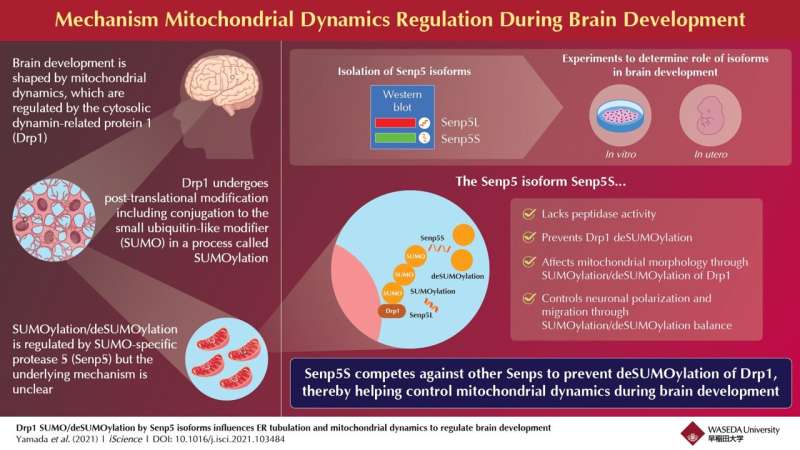
Understanding how the brain develops is crucial to formulating treatments and management protocols for a variety of developmental disorders, as well as degenerative neurological diseases. Right from the embryonic stage, brain development is facilitated by the differentiation of neurons (brain cells). These fundamental processes are regulated by the dynamics of mitochondria—subcellular structures involved in cellular energy metabolism. These dynamics encompass mitochondrial fission, by which a mitochondrion divides, and mitochondrial fusion, which helps mitochondria elongate.
Mitochondrial dynamics are primarily mediated by dynamin-related protein 1 (Drp1). Naturally, molecular mechanisms that affect the functioning of Drp1 are bound to influence brain development too. But thus far, little has been known on how exactly that happens. In a recent study, published in iScience, a group of scientists led by Professor Shin-ichi Sakakibara from Waseda University have discovered a new protein in the brain that helps regulate Drp1 and thus, brain function. “Drp1 undergoes a modification called ‘SUMOylation,’ which studies have shown to play a key role in many neurological disorders like Alzheimer’s and Parkinson’s. The protein we discovered targets this SUMOylation process, which makes it a very attractive option for potential therapies for SUMOylation-related diseases,” explains Sakakibara.
After Drp1 proteins are “translated,” or made, they undergo a modification by a protein called small ubiquitin-like modifier (SUMO). SUMOylated Drp1s are tagged by the body for degradation. Tagged Drp1s are later “untagged” to control the number of these proteins being degraded. This process is called deSUMOylation. Previous research has shown that deSUMOylation is catalyzed by a variant of an enzyme called SUMO-specific protease 5 (Senp5). This variant is called Senp5L and it helps break the bond between Drp1 and SUMO.
In their study, the research team discovered another variant of Senp5 that they named Senp5S. They then performed in vitro experiments using cell lines and in utero experiments using mouse embryos to study the effects of Senp5S and SUMOylation on mitochondrial dynamics and neuronal differentiation. The researchers found that unlike Senp5L, Senp5S had no “bond-breaking” (peptidase) activity. Instead, it competed with Senp5L at the reaction site and prevented deSUMOylation of Drp1 proteins, thereby indirectly regulating mitochondrial dynamics. The research team further found that the SUMOylation/deSUMOylation balance affected mitochondrial morphology as well as the tabulation of another crucial cellular structure that helps in protein production and assembly in the cell—the endoplasmic reticulum.
Speaking about their discovery, Sakakibara says, “Balanced Senp5L/Senp5S expression are essential for brain development. Our findings suggest a novel and vital role for post-translational SUMOylation in the tightly controlled process of neuronal differentiation and brain development. It also helps clarify the physiological significance of SUMOylation in the brain.”
Source: Read Full Article
